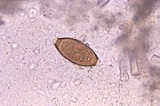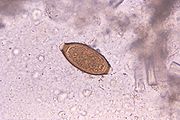
Trichuriasis
Encyclopedia
Trichuriasis is a parasitic infection primarily in the tissue of the cecum, appendix, colon and rectum that is caused by Trichuris trichiura (whipworm), an intestinal
parasitic nematode
(roundworm).
 Adult worms are usually 3–5 cm long, with females being larger than males as is typical of nematodes. The thin, clear majority of the body (the anterior, whip-like end) is the esophagus, and it is the end that the worm threads into the mucosa of the colon. The widened, pinkish gray region of the body is the posterior, and it is the end that contains the parasite’s intestines and reproductive organs.
Adult worms are usually 3–5 cm long, with females being larger than males as is typical of nematodes. The thin, clear majority of the body (the anterior, whip-like end) is the esophagus, and it is the end that the worm threads into the mucosa of the colon. The widened, pinkish gray region of the body is the posterior, and it is the end that contains the parasite’s intestines and reproductive organs.
Trichuris trichiura has characteristic football-shaped eggs, which are about 50-54 um long and contain polar plugs (also known as refractile prominences) at each end.
or albendazole
with ivermectin. Ivermectin’s safety in children under 15 kg and pregnant women has not yet been established.
Diarrheic patients may be treated with Imodium (loperamide hydrochloride) to increase the amount of drug contact with the parasites.
Intestine
In human anatomy, the intestine is the segment of the alimentary canal extending from the pyloric sphincter of the stomach to the anus and, in humans and other mammals, consists of two segments, the small intestine and the large intestine...
parasitic nematode
Nematode
The nematodes or roundworms are the most diverse phylum of pseudocoelomates, and one of the most diverse of all animals. Nematode species are very difficult to distinguish; over 28,000 have been described, of which over 16,000 are parasitic. It has been estimated that the total number of nematode...
(roundworm).
Agent (classification and taxonomy)
The phylum of Trichuris trichiura is Aschelminthes, while its class is Adenophorea, its order is Stichosmida, and its family is Trichocephaloidea. Its genus, Trichocephalus, was recorded as a more accurate name, however the generic name trichuris, which means “hair tail” (which implies that the posterior end of the worm is the attenuated section), remains the dominant name form used today.Synonyms
Human Whipworm, Trichocephaliasis, and Tricuriasis are all synonyms for Trichuriasis, human infection of the Trichuris trichiura intestinal nematode. In Spanish, trichuriasis is called “Tricuriasis,” while in it is known as “Trichuriose” in French and “Peitschenwurmbefall” in German.History of discovery
The first written record of Trichuris trichiura was made by Morgani, an Italian scientist, who identified the presence of the parasite in a case of worms residing in the colon in 1740. Exact Morphological description and figures were first recorded in 1761 by Roedere, a German physicist. Soon after morphology and visual representation of the worms, Trichuris trichiura was given taxonomy (during the 18th century).Reservoir
Humans are the main, but not the only reservoir for T. trichiura. As identification by microscopy is unreliable due to near identical sizes of different species of Trichuris spp. Recent research verified by the application of molecular techniques (PCR) that dogs are a reservoir for T. trichiura, as well as T. vulpis .Vector
Non-biting cyclorrhaphan flies (Musca domestica, Chrysomya rufifacies, Musca sorbens, Lucina cuprina, Calliphora vicina, Chrysomya bezziana and Wohlfarthia magnifica) have been found to carry Trichuris trichiura. A study in two localized areas in Ethiopia found cockroaches were carriers for several human intestinal parasites, including Trichuris trichiura.Transmission
Humans can become infected with the parasite due to ingestion of infective eggs by mouth contact with hands or food contaminated with egg-carrying soil. However, there have also been rare reported cases of transmission of trichuris trichiura by sexual contact. Some major outbreaks have been traced to contaminated vegetables (due to presumed soil contamination).Life cycle
Unembryonated eggs (unsegmented) are passed in the feces of a previous host to the soil. In the soil, these eggs develop into a 2-cell stage (segmented egg) and then into an advanced cleavage stage. Once at this stage, the eggs embryonate and then become infective, a process that occurs in about 15 to 30 days). Next, the infective eggs are ingested by way of soil-contaminated hands or food and hatch inside the small intestine, releasing larvae into the gastrointestinal tract. These larvae burrow into a villus and develop into adults (over 2–3 days). They then migrate into the cecum and ascending colon where they thread their anterior portion (whip-like end) into the tissue mucosa and reside permanently for their year-long life span. About 60 to 70 days after infection, female adults begin to release unembryonated eggs (oviposit) into the cecum at a rate of 3,000 to 20,000 eggs per day, linking the life cycle to the start.Incubation period
- The exact incubation period of Trichuris trichiura is unknown, however immature eggs in soil under favorable conditions take about three weeks to mature: 15–30 days, 10 days minimum to mature before ideal ingestion by the human host. Favorable conditions for maturation of eggs is warm to temperate climates with adequate humidity or precipitation, as ova are resistant to cold, but not resistant to drying.
- Once ingested, the larva will remain dug into a villus in the small intestine for about 2–3 days until it is fully developed for migration to the ileo-cecum section of the gastrointestinal tract.
- The average total life span of Trichuris trichiura is one year, although there have been longer cases reported, lasting as long as five years (Note: inadequate treatment and re-infection are likely to play a role in this).
Morphology

Trichuris trichiura has characteristic football-shaped eggs, which are about 50-54 um long and contain polar plugs (also known as refractile prominences) at each end.
Signs and symptoms
- Light infestations are frequently asymptomatic (have no symptoms).
- Heavier infestations, especially in small children, can present gastrointestinal problems including abdominal pain and distention, bloody or mucous-filled diarrhea, and tenesmus (feeling of incomplete defecation, generally accompanied by involuntary straining). While damage may be done to the GI tissue and appendicitis may be brought on (by damage and edema of the adjacent lumen) if there are large numbers of worms or larvae present, it has been suggested that the embedding of the worms into the ileo-cecal region may also make the host susceptible to bacterial infection. Severe infection may also present with rectal prolapse, although this is typically seen only in heavy infections of small children. High numbers of embedded worms in the rectum cause edema, which causes the rectal prolapse. The prolapsed, inflamed and edematous rectal tissue may even show visible worms.
- Growth retardation, weight loss, nutritional deficiencies, and anemia (due to long-standing blood loss) are also characteristic of infection, and these symptoms are more prevalent and severe in children. Does NOT commonly cause eosinophilia.
- Coinfection of Trichuris trichiura with other parasites is common and with larger worm burdens can cause both exacerbation of dangerous trichuriasis symptoms such as massive gastrointestinal bleeding (shown to be especially dramatic with coinfection with Salmonella typhi) and exacerbation of symptoms and pathogenesis of the other parasitic infection (as is typical with coinfection with Schistosoma mansoni, in which higher worm burden and liver egg burden is common). Parasitic coinfection with HIV/AIDS, tuberculosis, and malaria is also common, especially in Sub-saharan Africa, and helminth codinfection adversely affects the natural history and progression of HIV/AIDS, tuberculosis, and malaria and can increase clinical malaria severity. In a study performed in Senegal, infections of soil-transmitted helminths like Trichuris trichiura (as well as schistosome infections independently) showed enhanced risk and increased incidence of malaria.
Diagnosis
- A stool ova and parasites exam reveals the presence of typical whipworm eggs. Typically, the Kato-Katz thick-smear technique is used for identification of the Trichuris trichiura eggs in the stool sample.
- Although colonoscopy is not typically used for diagnosis, as the adult worms can be overlooked, especially with imperfect colon, there have been reported cases in which colonoscopy has revealed adult worms. Colonoscopy can directly diagnose trichuriasis by identification of the threadlike form of worms with an attenuated, whip-like end. Colonoscopy has been shown to be a useful diagnostic tool, especially in patients infected by only a few male worms and with no eggs presenting in the stool sample.
Management and therapy
The highest clearance rates are obtained by combining mebendazoleMebendazole
Mebendazole or MBZ is a benzimidazole drug developed by Janssen Pharmaceutica and marketed as Vermox, Ovex, Antiox, and Pripsen...
or albendazole
Albendazole
Albendazole, marketed as Albenza, Eskazole, Zentel and Andazol, is a member of the benzimidazole compounds used as a drug indicated for the treatment of a variety of worm infestations. Although this use is widespread in the United States, the U.S. Food and Drug Administration has not approved...
with ivermectin. Ivermectin’s safety in children under 15 kg and pregnant women has not yet been established.
Diarrheic patients may be treated with Imodium (loperamide hydrochloride) to increase the amount of drug contact with the parasites.
Epidemiology
Trichuris trichiura is the third most common nematode (roundworm) of humans. Infection of trichuris trichiura is most frequent in areas with tropical weather and poor sanitation practices. Trichuriasis occurs frequently in areas in which human feces is used as fertilizer or where defecation onto soil takes place. Trichuriasis infection prevalence is 50 to 80 percent in some regions of Asia (noted especially in China and Korea) and also occurs in rural areas of the southeastern United States. Infection is most prevalent among children, and in North America, infection occurs frequently in immigrants from tropical or sub-tropical regions. It is estimated that 600-800 million people are infected worldwide with 3.2 billion individuals at risk.Public Health and Prevention Strategies/Vaccines
Improved facilities for feces disposal have decreased the incidence of whipworm. Handwashing before food handling, and avoiding ingestion of soil by thorough washing of food that may have been contaminated with egg-containing soil are other preventive measures. Mass Drug Administration (preventative chemotherapy) has had a positive effect on the disease burden of trichuriasis in East and West Africa, especially among children, who are at highest risk for infection. Improvement of Sewage and Sanitation systems, as well as improved facilities for feces disposal have helped to limit defecation onto soil and contain potentially infectious feces from bodily contact. A study in a Brazil Urban Centre demonstrated a significant reduction in prevalence and incidence of geohelminth infection, including trichuriasis, following implementation of a city-wide sanitation program. A 33% reduction in prevalence of trichuriasis and a 26% reduction in incidence of trichuriasis was found in the study performed on 890 children ages 7–14 years old within 24 different sentinel areas chosen to represent the varied environmental conditions throughout the city of Salvador, Bahia, Brazil. Control of Soil Fertilizers has helped eliminate the potential for contact with human fecal matter in fertilizer in soil.Current Public Health Challenges in Prevention
Limited access to essential medicine poses a challenge to the eradication of trichuriasis worldwide. Also, it is a public health concern that rates of post-treatment re-infection need to be determined and addressed to diminish the incidence of untreated re-infection. Lastly, with mass drug administration strategies and improved diagnosis and prompt treatment, detection of emergence of antihelmintic drug resistance should be examined.External links
- http://web.gideononline.com/web/epidemiology/
- http://www.gastrointestinalatlas.com/English/Colon_and_Rectum/Parasites/parasites.html

